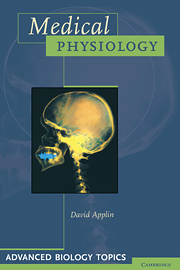Book contents
- Frontmatter
- Contents
- 1 What is disease?
- 2 Understanding the immune system
- 3 The control of bleeding
- 4 Heart disease
- 5 Physiological effects of exercise
- 6 Food and health
- 7 Diseases of the gaseous exchange system
- 8 Kidney failure
- 9 Fertility and contraception
- 10 The brain: memory, ageing and the effects of drugs
- 11 Medical genetics
- 12 Biotechnology and medicine
- Index
10 - The brain: memory, ageing and the effects of drugs
Published online by Cambridge University Press: 05 June 2012
- Frontmatter
- Contents
- 1 What is disease?
- 2 Understanding the immune system
- 3 The control of bleeding
- 4 Heart disease
- 5 Physiological effects of exercise
- 6 Food and health
- 7 Diseases of the gaseous exchange system
- 8 Kidney failure
- 9 Fertility and contraception
- 10 The brain: memory, ageing and the effects of drugs
- 11 Medical genetics
- 12 Biotechnology and medicine
- Index
Summary
The title of this chapter raises questions that are at the leading edge of research. To make sense of this subject, we can investigate brain structure, its neurones (nerve cells) and synapses or its biochemistry, or seek a route for our understanding through functional deficiences such as Alzheimer's disease, Creutzfeldt-Jacob disease that constitute brain dementia. In fact, the whole picture only emerges through the combination of level upon level of organisation – molecules to memory. We shall adopt just such a multilevel approach to glimpse the functioning brain at work in health and disease.
The human brain weighs about 1.3 kg. Divided into different regions – forebrain, midbrain and hindbrain – it is the body's thinking and control centre. Reactions to stimuli that are under the brain's control are called voluntary responses. Memory and learning are also controlled by the brain.
The neurones in the brain are called multipolar neurones because each one has numerous dendrites which can form synapses with incoming axons, connecting each multipolar neurone to as many as 80 000 other neurones. It has been estimated that the human brain consists of up to 20 000 million neurones, but this does not take into account the non-neural glia cells in which neurones are embedded. Supporting, nurturing and protecting the neurones, glia cells outnumber neurones ten-fold.
Memory
Today, understanding the mechanisms of memory is one of the great scientific challenges. Memory allows us to recall past experiences, connecting learning to remembering.
- Type
- Chapter
- Information
- Medical Physiology , pp. 102 - 115Publisher: Cambridge University PressPrint publication year: 1997



